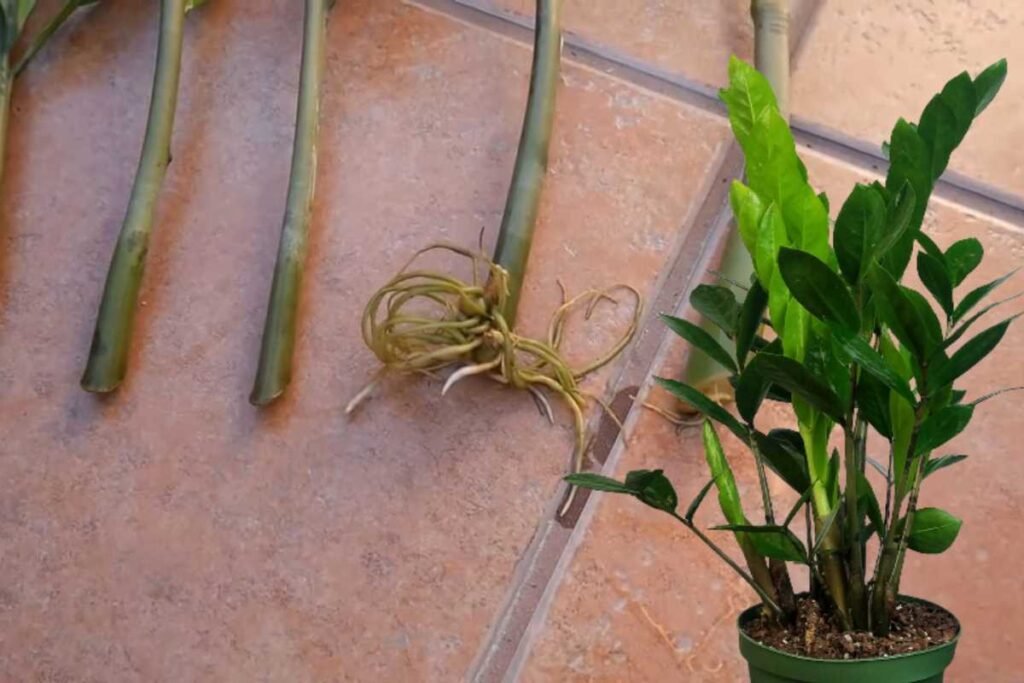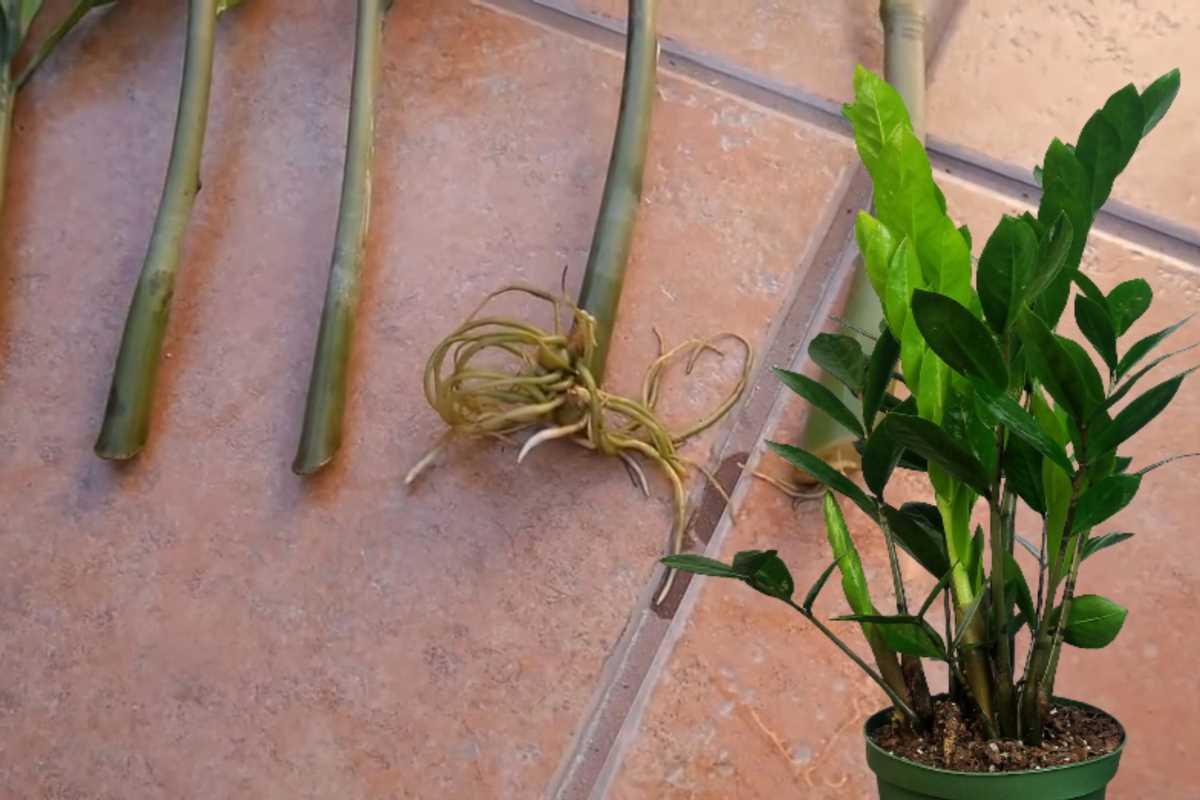The ZZ plant, scientifically known as Zamioculcas zamiifolia, is a popular choice among plant enthusiasts and interior decorators alike. Originating from Eastern Africa, particularly the regions of Kenya and Tanzania, the ZZ plant has gained widespread acclaim due to its hardy nature and attractive appearance. This perennial plant is renowned for its glossy, dark green leaves that can add a touch of elegance to any setting, whether it be a home or an office space.
One of the key reasons for the ZZ plant’s popularity is its remarkable adaptability. These plants can thrive in a variety of environments, from low-light conditions to bright, indirect sunlight. They are also highly tolerant of drought, making them an excellent option for those who may not have a green thumb or a strict watering schedule. The ZZ plant’s ability to withstand neglect without losing its luster is a testament to its resilience and low-maintenance requirements.
Aside from their aesthetic and practical appeal, ZZ plants are also favored for their air-purifying qualities. According to studies conducted by NASA, ZZ plants can help remove toxins such as xylene, toluene, and benzene from the air, contributing to a healthier indoor environment. This makes them a beneficial addition to both living and working spaces.
Many plant enthusiasts are drawn to ZZ plants not just for their beauty and hardiness, but also for the ease with which they can be propagated. Learning how to propagate a ZZ plant can be a rewarding experience, allowing plant lovers to expand their collection or share the joy of plant ownership with others. Whether through division, leaf cuttings, or stem cuttings, propagating ZZ plants can be a straightforward and gratifying endeavor.
In this comprehensive guide, we will explore the various methods of ZZ plant propagation, providing you with the knowledge and confidence to successfully grow new plants from your existing ZZ plant.

Benefits of Propagating ZZ Plants
Propagating ZZ plants offers a multitude of benefits, both practical and aesthetic. One of the most immediate advantages is cost savings. Purchasing mature ZZ plants can be expensive, but propagating them allows you to expand your collection without additional costs. By learning how to propagate a ZZ plant, you can create multiple new plants from a single parent, effectively multiplying your greenery without impacting your budget.
The joy of growing new plants from cuttings or divisions is another compelling benefit. Watching a ZZ plant propagate and develop over time can be a rewarding experience. This process not only fosters a deeper connection with the plant but also enhances your gardening skills. Furthermore, successfully propagating a ZZ plant can provide a sense of accomplishment and pride as you witness your efforts come to fruition.
Sharing is another benefit of propagating ZZ plants. Whether you want to gift a plant to a friend, family member, or colleague, propagating your own ZZ plants allows you to share the joy of green living with others. This act of sharing not only spreads the aesthetic and health benefits but also strengthens social bonds through the act of giving.
Moreover, propagation can lead to healthier, more robust plants. When a ZZ plant is propagated, it often results in stronger growth due to the rejuvenation process involved. New plants tend to be more adaptable and resilient, contributing to a thriving indoor garden. This resilience is particularly beneficial for indoor air quality, as ZZ plants are known for their air-purifying qualities. By propagating ZZ plants, you can enhance the air quality of your living spaces, promoting a healthier indoor environment.
Lastly, propagated ZZ plants contribute significantly to home and office decoration. Their glossy, dark green leaves add an element of sophistication and natural beauty to any setting. By mastering the process of how to propagate a ZZ plant, you can ensure a steady supply of these aesthetically pleasing plants, enhancing the visual appeal and ambiance of your surroundings.
Understanding the Propagation Methods
Propagation of ZZ plants can be accomplished through several methods, each offering unique advantages and challenges. The primary techniques include stem cuttings, leaf cuttings, and division. Each method varies in terms of success rate, time to establish new plants, and overall ease, which can help you determine the best approach for your needs.
Stem Cuttings
Stem cuttings are a popular method for propagating ZZ plants. This technique involves cutting a healthy stem, typically around 6 inches long, and placing it in water or directly into soil. The stem cutting should develop roots within a few weeks to a few months. One of the primary benefits is the relatively quick root development compared to other methods. However, there is a moderate risk of stem rot if not properly cared for, particularly when using water propagation.
Leaf Cuttings
Leaf cuttings involve taking individual leaves from the ZZ plant and placing them in soil. This method tends to be slower, as it can take several months for roots to develop and even longer for new shoots to appear. Leaf cuttings have a high success rate if done correctly but require patience. A significant advantage is the minimal risk of rot, making it a reliable albeit time-consuming method.
Division
Division is another effective approach, particularly for mature ZZ plants with multiple rhizomes. This method involves carefully separating the plant into smaller sections, each with at least one rhizome, and replanting them. Division offers immediate results, as the separated sections are already established plants. The main challenge is the risk of damaging the roots during separation, which can affect the plant’s health. Despite this, division is highly effective and provides instant gratification.
When deciding how to propagate a ZZ plant, consider the time you can invest and your experience level. Stem cuttings offer quicker results but require more attention. Leaf cuttings are ideal for those who can afford to wait and prefer a lower-risk method. Division is best for those looking for immediate new plants but is most suitable for mature ZZ plants.
Materials Needed for ZZ Plant Propagation
Propagating a ZZ plant requires a few essential materials to ensure successful growth. First and foremost, clean, sharp scissors or pruners are indispensable. These tools are crucial for making precise cuts on the plant, which minimizes damage and promotes healthy growth. It is advisable to sterilize the scissors or pruners with rubbing alcohol before use to prevent the spread of any pathogens.
Another vital material is rooting hormone. This substance accelerates root development and increases the chances of successful propagation. Rooting hormone can be found in most garden centers or online stores. When using rooting hormone, simply dip the cut end of the ZZ plant stem or leaf into the powder or gel before planting.
A suitable potting mix is also essential for propagating ZZ plants. Opt for a well-draining mix that retains some moisture but does not become waterlogged. A combination of cactus soil and perlite or sand works well. This mixture provides the right balance of aeration and moisture retention, promoting root growth without the risk of rot.
Containers for the cuttings are another necessity. Choose small pots or containers with drainage holes to avoid waterlogging, which can lead to root rot. It’s best to use new or thoroughly cleaned containers to prevent any contamination.
Lastly, plastic bags or covers are useful for creating a humid environment around the cuttings. High humidity is crucial for the initial stages of propagation as it helps prevent the cuttings from drying out. Simply place a plastic bag over the container, ensuring it does not touch the cutting, and secure it with a rubber band. This creates a mini-greenhouse effect, maintaining the necessary moisture levels.
These materials for ZZ plant propagation can be sourced from local garden centers, hardware stores, or online retailers. Ensuring you have all the necessary materials before starting the propagation process will set you on the path to successfully growing new ZZ plants.
How to Propagate a ZZ Plant: Step-by-Step
Propagating a ZZ plant can be a rewarding endeavor, whether you’re using stem cuttings, leaf cuttings, or division. Each method has its unique steps and requirements, but all aim to produce healthy, new plants. Here’s a detailed, step-by-step guide on how to propagate a ZZ plant using the methods that I already mentioned before:
Stem Cuttings
Prepare the Plant: Select a healthy stem with multiple leaves. Ensure your cutting tools are sanitized to avoid any infections.
Make the Cuttings: Using a clean, sharp knife or scissors, cut a stem just below a leaf node. Aim for a cutting that is 4-6 inches long.
Apply Rooting Hormone: Dip the cut end into rooting hormone to encourage root development.
Plant the Cuttings: Insert the cut end into a pot filled with a well-draining potting mix. Water lightly and cover with a plastic bag to create a humid environment.
Care for the Cuttings: Place the pot in a warm, bright area but out of direct sunlight. Keep the soil moist but not waterlogged. Roots should develop in a few weeks.
Leaf Cuttings
Prepare the Plant: Select a mature, healthy leaf from the ZZ plant.
Make the Cuttings: Using a sharp knife, cut the leaf at the base.
Apply Rooting Hormone: Dip the cut end of the leaf into rooting hormone.
Plant the Cuttings: Insert the cut end of the leaf into a potting mix. Water sparingly and cover with plastic to maintain humidity.
Care for the Cuttings: Place in a warm, bright location out of direct sunlight. Keep the soil lightly moist. Root development may take several months.
Division
Prepare the Plant: Carefully remove the ZZ plant from its pot. Gently shake off excess soil to expose the root system.
Divide the Plant: Using a sharp, sterile knife, divide the rhizomes (underground stems) ensuring each section has at least one stem and roots attached.
Plant the Divisions: Place each division into a separate pot filled with a well-draining potting mix. Water thoroughly.
Care for the Divisions: Position the pots in a warm, bright area out of direct sunlight. Maintain slightly moist soil. New growth should appear within a few weeks.
By following these detailed steps, you can successfully propagate a ZZ plant using different methods. Each approach offers a unique way to expand your collection and enjoy the beauty of these resilient plants.
Caring for Newly Propagated ZZ Plants
Once you have successfully planted your ZZ plant cuttings, ensuring their proper care is crucial for their growth and development. The early stages of propagation demand particular attention to humidity, light, and watering to foster a conducive environment for root and shoot formation.
Maintaining adequate humidity is essential. Newly propagated ZZ plants thrive in environments with high humidity levels. You can achieve this by misting the cuttings regularly or by placing a plastic cover over them to create a mini-greenhouse effect. This helps to prevent the cuttings from drying out and supports the development of new roots.
Light is another critical factor. ZZ plants prefer indirect, bright light. Direct sunlight can be too harsh for young cuttings and may cause scorching, while too little light can hinder growth. Position your cuttings in an area that receives filtered light to strike the perfect balance. If natural light is insufficient, consider using grow lights to supplement.
Watering should be done judiciously. Overwatering can lead to root rot, which is a common issue for ZZ plants. Allow the soil to dry slightly between waterings. A good practice is to water the cuttings when the top inch of soil feels dry to the touch. Ensure that the soil is well-draining to prevent water from pooling, as this can increase the risk of rot.
Be vigilant for common issues such as rot and pest infestations. Rot often manifests as mushy stems or discolored leaves. If you notice any signs, reduce watering and improve air circulation around the cuttings. Pest infestations, although less common, can include spider mites or mealybugs. Regularly inspect your cuttings and treat any infestations promptly with insecticidal soap or neem oil.
By providing the right conditions and monitoring for potential problems, your newly propagated ZZ plants will have the best chance at thriving. Proper care in these early stages sets the foundation for robust growth and healthy development.
Troubleshooting Common Problems
When learning how to propagate a ZZ plant, it is crucial to identify and address common issues that may arise during the process. One frequent problem is cuttings not rooting. This can occur due to several factors, including insufficient light, overly wet soil, or a lack of humidity. To encourage rooting, ensure your cuttings are placed in bright, indirect light and the soil remains moist but not waterlogged. Utilizing a humidity dome or plastic bag over the cuttings can also help maintain adequate humidity levels.
Yellowing leaves on your ZZ plant cuttings can be another sign of distress. This issue often stems from overwatering or poor drainage. To prevent yellowing leaves, use a well-draining soil mix and water only when the top inch of soil feels dry. Additionally, avoid placing the cuttings in direct sunlight, as this can cause stress and contribute to leaf discoloration.
Mold growth is another common problem during ZZ plant propagation. Mold typically develops in overly moist environments with poor air circulation. To prevent mold, ensure your propagation setup is in a well-ventilated area and avoid overwatering. If mold does appear, remove the affected areas immediately and adjust your watering schedule to allow the soil to dry out between waterings. Using a fungicide can also help control mold growth.
In cases where cuttings still fail to root despite proper care, consider using rooting hormones. These products can enhance root development and increase the success rate of propagation. Always follow the manufacturer’s instructions when applying rooting hormones to ensure optimal results.
By addressing these common problems and taking preventive measures, you can improve your chances of successfully propagating a ZZ plant. With proper care and attention, you will soon have healthy, thriving new plants to enjoy.
Conclusion and Additional Tips
In conclusion, propagating a ZZ plant is a rewarding and relatively simple process that can yield beautiful results. By following the methods outlined in this guide—whether through stem cuttings, leaf cuttings, or division—you can successfully expand your ZZ plant collection. Each method has its unique steps and timing, but with patience and careful attention, you will see new growth and vibrant plants emerging.
There are several benefits to propagating ZZ plants. Not only does it allow you to create new plants for yourself or to share with friends and family, but it also provides an opportunity to learn more about plant care and the fascinating world of propagation. As you gain experience, you’ll find that propagating ZZ plants can be both a relaxing and educational hobby.
For successful propagation, ensure you have the right tools and conditions. Use clean, sharp tools to take cuttings, and always provide a suitable medium for rooting. Proper lighting, humidity, and temperature are key factors in encouraging healthy root development. Additionally, be patient; ZZ plants are known for their slow growth, and it may take several weeks or even months to see significant progress.
Long-term care is just as important as the initial propagation steps. Regularly check the moisture levels of the soil, avoid overwatering, and provide adequate light to maintain the health of your new ZZ plants. Fertilize sparingly and keep an eye out for any signs of pests or diseases.
We encourage you to experiment with different propagation techniques and enjoy the process of growing new plants. Joining online plant communities can provide further support and a platform to share your experiences and successes. These communities are great resources for advice, inspiration, and connecting with fellow plant enthusiasts. Happy propagating!

